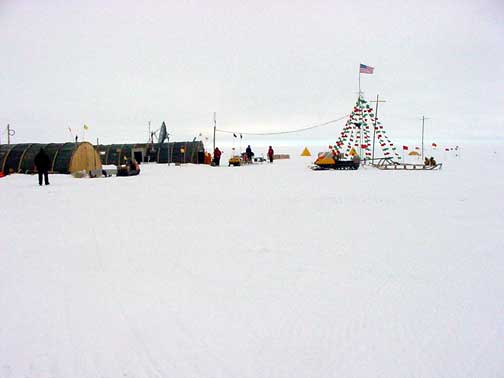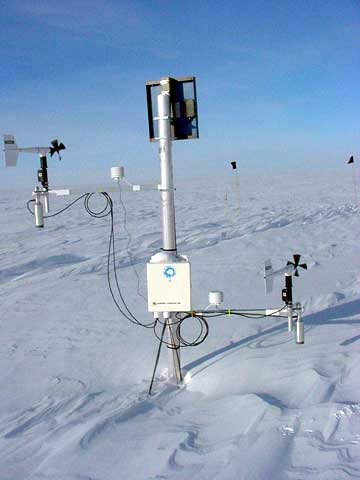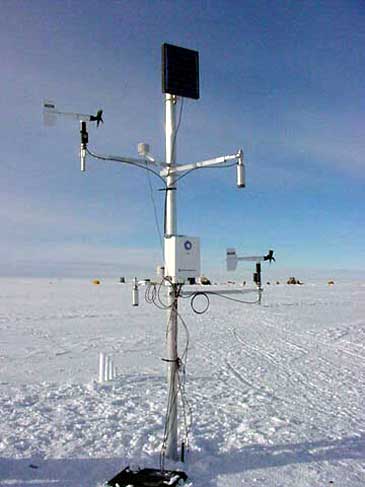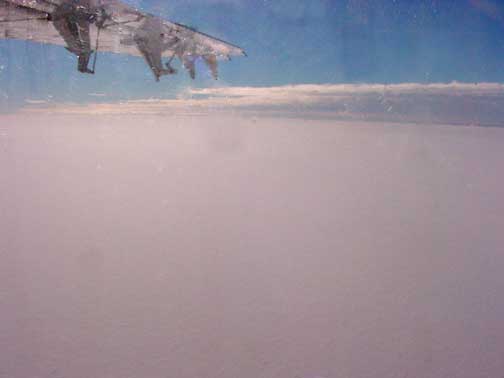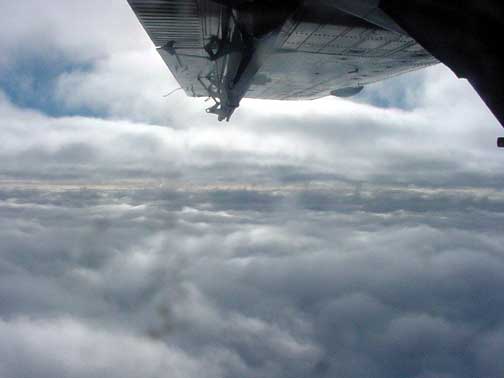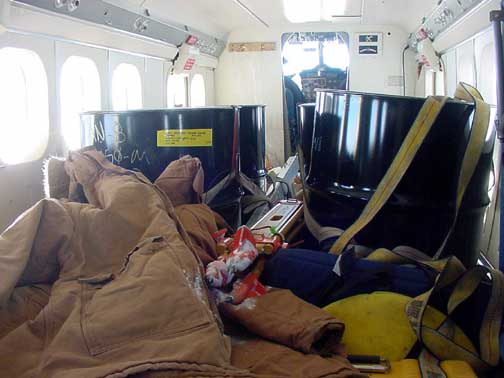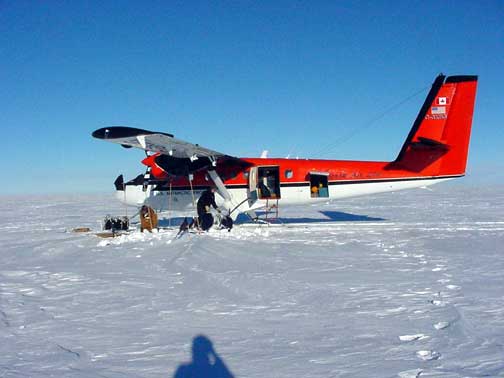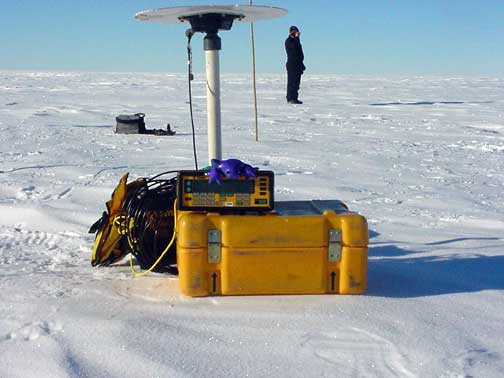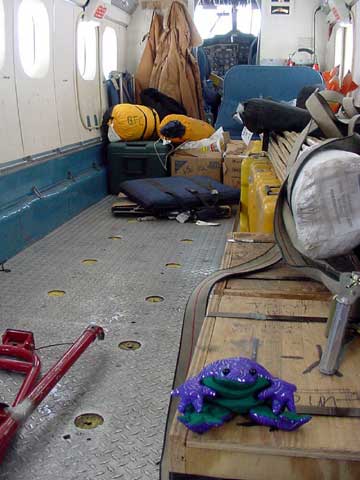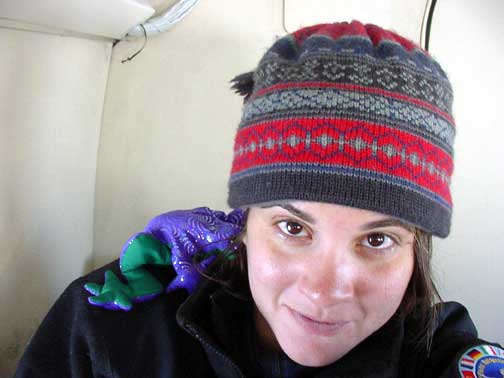
- 1999
- 2000
- 2001
- 2002
- 2003
- 2006
- 2007
Week 9 - December 23, to December 29, 2002
Date: 12/29/02
Latitude: 88°, 00', 07.70" South
Longitude: 107°, 58', 58.47" West
Temperature: −23°C( −10°F)
Wind speed: 10 knots
Wind Chill: −34°C( −29°F)
Wind direction: Southerly
Meters of ice collected: 575
Notes on daily life:
By Jim Laatsch
Site 5! This is our last stop before the pole and its proximity has motivated everyone’s energy levels despite the many hours of exhausting driving.
This log is actually going to backtrack a bit and talk about a project that we worked on at the last site (Site 4) and at Site 2. ITASE is a broad
scientific endeavor and there are actually many more people who work with ITASE data than just those of us down here on the traverse. One prime example
of this is the work done for Dr. Mary Albert, a research scientist at the US Cold Regions Research and Engineering Laboratory (CRREL). Mary is one
of the world’s experts on the physical properties of snow and firn and part of her work with ITASE focuses on snow microstructure and permeability
to investigate how chemicals are redistributed in firn. (Firn is the term used for any snow that has survived the first melt season before it becomes
solid ice.)
One of the characteristics of firn that is very important to Mary’s work is the pore space within the snow column. Porosity refers to the amount of interstitial space between snow grains, the amount of space that is filled up with air. Imagine if you took a glass and filled it with Styrofoam packing peanuts, there would be a lot of empty space between the peanuts. This empty space is essentially porosity. If you were to blow down into the glass, the air would easily circulate through the big empty spaces around the peanuts. If instead of peanuts, you were to fill up the glass with fine sand there wouldn’t be much free space available between the tiny sand grains and if you blew into the glass this time the air wouldn’t easily circulate through it. The glass full of sand would have comparatively less porosity than the glass full of Styrofoam peanuts. By understanding how much pore space is available in the snow Mary can investigate how easily air can circulate around in the firn column and redistribute chemical species which might effect the concentrations and layering of ions within the snow. Mary has been working in a different part of Antarctica this season so she left us some wonderfully detailed instructions and we were able to collect data for her independently.
To start off, we drilled three ice cores, one 15 meters deep and two 2 meters deep. The 15 meter core will be shipped back to CRREL intact and the 2 meter cores were processed in the field. The first 2 meter core was cut up into sections about 10 cm each, then it was coated with a chemical called Dimethyl Phthalate that seeps into the pore space, freezes, and thus preserves the original shape of the interstitial pathways within the core. By far the most difficult part of this job is keeping from spilling the Dimethyl because it isn’t a terribly nice chemical. Luckily Dan, who is much neater and more experienced than I am, was able to provide some ultra valuable assistance with this. The other 2 meter core was sliced up into similar sized chunks and run through a machine called a Permeameter that was built by Mary Albert and Frank Perron back at CRREL. The Permeameter forces air through the core at varying flow rates and measures the amount of pressure buildup. From this Mary can begin to quantify how much pore space these is in the firn and how easily air can flow through it. Is it like the glass full of sand or Styrofoam pieces? The vast majority of the work on this project will be done by Mary and her students, Ursula, Zoe, and Margie back at CRREL but it was nice to be involved for a bit down here in the field and get to learn more about an entirely different project than my own.
Date: 12/28/02
Latitude: 88°, 00', 07.70" South
Longitude: 107°, 58', 58.47" West
Temperature: −25°C( −13°F)
Wind speed: 10 knots
Wind Chill: −36°C( −33°F)
Wind direction: Southeasterly
Meters of ice collected: 506
Notes on daily life:
By Daniel Dixon
Hooray! We have arrived at Site 5. We have been here for all of half an hour and already the camp is a hive of activity no time to waste around here.
Dan has completed the surface snow sampling, Markus, Betsy, Karl, and Lynn are busy preparing the atmospheric tent, Blue and Gordon are preparing
to conduct the GPS survey around camp, Susan, Mark, Dan and Paul are preparing the 2, and 3–inch drill sites, Jim is processing the shallow radar
data, Brian is processing the deep radar data, and Andrea is preparing yet another fantastic feast. Wow!
The journey to Site 5 turned out to be quite eventful; soon after leaving Hercules Dome (Site 4), we dropped down about 50 meters in elevation. A few tens of kilometers later we began to climb again. As we headed towards the East Antarctic Plateau, we encountered several steep hills in short succession. The first hill rose about 20 meters in 100 kilometers, this may not sound like much but when you are dragging approximately 50,000 pounds of weight behind you it is enough to slow you down considerably. The second hill was even steeper; it rose over 50 meters in 12 kilometers. This was steep enough to stop us completely. When a tractor gets stuck it’s tracks keep on spinning but it does not move, the result is a large, deep hole with a tractor in the bottom of it not much fun to dig out with shovels! To ascend the steep hill we had to hook both tractors together and pull one train at a time. Thankfully, the hill only lasted for a couple of kilometers so we did not waste too much time in the process.
Now we are at Site 5 and plan to spend about 48 hours here to conduct our experiments, after this we shall head straight for the South Pole. Let’s see if we can make it by New Years Day.
Date: 12/27/02
Latitude: 86°, 58', 44" South
Longitude: 107°, 56', 19" West
Temperature: −25°C( −13°F)
Wind speed: 10 knots
Wind Chill: −36°C( −33°F)
Wind direction: Westerly
Meters of ice collected: 506
Notes on daily life:
By Gordon Hamilton
The day after the day after Christmas – what some us call December 27. We woke early this morning to witness a bank of fog come rolling in over camp.
Being close to the summit of Hercules Dome, it’s not unusual for local patches of fog to form in calm conditions. By the time we had eaten
our breakfast mcmuffins, the fog had shrouded our camp in a cold white haze.
Today is our traverse day, and because we had done most of our packing last night there was not a lot to do before we were able to leave. The final sleds were arranged in the trains and the tractor engines were warmed and, a couple of hours after breakfast, we were on our way. So far progress has been good and we are currently about 50 km from our camp at Hercules Dome. Our only slowdown came near the start of the travel day when we had fog conditions; the small droplets of moisture in the air freeze and form something called diamond dust. Because diamond dust is so fine it clogs up the engine cooling grills on the tractors and causes the engines to overheat. It means we have to stop and brush away the diamond dust periodically. When it’s bad, the stops come every 1 km or so, which really slows progress. Luckily, now that we are farther from the summit of the dome, the fog and diamond dust have dissipated.
Apart from the diamond dust, the travel has been uneventful. Riding in the Blue Room takes some getting used to because there are no large windows so we can see when we might hit a bump or sway from side to side. Although the surface of the ice sheet looks flat, it is actually composed of lots of little bumps and ripples formed by blowing snow. These features are called sastrugi. Every time our sled slides over a sastrugi the Blue Room shakes from side to side, as do the other buildings on sleds. The tractor drivers, on the other hand, have cushioned seats and get a much smoother ride. A bad travel day is when the sastrugi are spaced closely together. Luckily today has been relatively smooth for the most part.
Sastrugi form when snow being blown across the surface by the wind gets trapped by an obstruction (like an existing sastrugi). They always form with their long axes parallel to the wind direction. The region we are traveling across now is dominated by katabatic winds (currents of cold air that follow the slope) from East Antarctica. Because we are driving into the dominant wind direction, we encounter most of the sastrugi lengthwise. That makes for a much smoother ride compared to crossing sastrugi sideways.
Sastrugi make for uncomfortable travel conditions, but they can actually be quite useful for some purposes. Whenever we arrive at a new ice core site, we use the sastrugi orientation to determine the prevailing wind direction bringing snow to that site. Pilots of the Twin Otter aircraft (that our roving team member Leigh Stearns has been using for the past week to revisit sites from previous ITASE field seasons) use sastrugi directions to assess wind patterns when coming in to land at remote ice sheet sites.
And so the ride goes on… Markus and Susan are driving the lead train at the moment and have probably reached disk 7 of the Harry Potter CD set that ITASE investigator Deb Meese sent to the field for us to listen to on the long drives. Lynn is driving the second tractor, doing his best to give those of us in the Blue Room a smooth ride. Blue is working on shallow radar and GPS profiling, having just taken over from Jim who worked the first 6 hour shift. Andrea is knitting, Mark and Paul are watching a movie and the rest of the team seem to be in la–la land.
Date: 12/26/02
Latitude: 86°, 30', 08.99" South
Longitude: 107°, 59', 24.64" West
Temperature: −27°C( −17°F)
Wind speed: 1 knot
Wind Chill: −28°C( −17°F)
Wind direction: Westerly
Meters of ice collected: 503
Notes on daily life:
By Gordon Hamilton
The day after Christmas, what some us from other parts of the world call Boxing Day. Quite appropriate really, because a large part of the day was
spent moving boxes around in preparation for our departure to our final site tomorrow morning. Site 4, or Hercules Dome, has been good to us but
it will be good to be moving farther into East Antarctica and nearer the end of our adventure.
Hercules Dome sits a few hundred feet above the surrounding East Antarctic Ice Sheet. Notwithstanding its impressive sounding name, it is actually almost impossible to tell that we are close to the summit of the dome. Such is the scale and topography of the Antarctic Ice Sheet. The dome itself is about 100 km long and 60 km wide. It is one of a number of domes in East Antarctica others include Titan Dome, Talos Dome, Dome Concordia, Dome Argus and Dome Fuji.
These domes probably represent the former high elevations of the Ice Age ice sheet. If that is the case, we might expect them to be relaxing to a new equilibrium surface (or flattening out). The same thing happens if you upturn your bowl of oatmeal on the table very quickly it will change from a rounded standing–up lump to a flattened mess covering a larger part of the table (and your parents might be mad, but tell them it’s a science experiment!). Ice sheets do the same thing when their supply of new snow decreases or their flow speeds increase only they relax, or flatten out, much more slowly than upturned bowls of oatmeal. The experiments that Blue and Gordon are doing will tell us if Hercules Dome is getting flatter with time. Their GPS measurements allow them to calculate the rate that the ice sheet is changing thickness. Today, they finished their survey measurements and drilled a shallow 20–meter ice core that they will use to determine the snow accumulation rate. A year from now they will revisit this site by airplane and conduct repeat GPS surveys to allow them to complete the calculations.
The other drill team of Mark, Dan, Paul and Susan persevered through a few drill problems to complete their ice core at a depth of 72 meters. The fact that we are having extremely pleasant weather (cold, but relatively warm in the absence of any wind) undoubtedly made Mark’s mechanical repair work a little less harsh on his bare fingers.
Markus and Betsy performed a full day of science at their atmospheric chemistry tent. One of their experiments was sucking air out of the surface snow to compare its chemistry with the air above the results will be useful for understanding the chemical signatures that are recorded in ice cores. The calm conditions also allowed for several ozone sounding balloon launches.
Brian and Lynn went on a mini–traverse to study the subglacial controls on the location of Hercules Dome. For example, does the dome sit on an elevated region of subglacial mountains? Brian’s radar looks through about 3000 meters of ice to map the shape of the underlying rocks. Today, they collected over 75 km of data together with yesterday’s mini–traverse in the opposite direction they have over 120 km of radar profile data across Hercules Dome.
Around camp, Carl and Andrea were busy as usual taking care of the essential details of field life that we tend to overlook when we are busy with science. Carl organized the fuel for our next traverse leg and performed some preventive maintenance on one of the tractors. Andrea worked her magic in the kitchen, almost outdoing her efforts on Christmas Day with a fabulous meal of stir–fried meats and vegetables. With a little extra hot sauce, it was just the right kind of meal to warm up the hungry bunch coming in from a day in the cold.
Date: 12/25/02
Latitude: 86°, 30', 08.99" South
Longitude: 107°, 59', 24.64" West
Temperature: −26°C( −15°F)
Wind speed: 8 knots
Wind Chill: −37°C( −35°F)
Wind direction: Westerly
Meters of ice collected: 464
Notes on daily life:
By Betsy Youngman
Christmas Day; music, warm food and Christmas greetings began our day. Sparkling snow, calm winds and blue skies gave the day a joyful feel. We all
walked to our respective work areas with a little extra bounce in our steps. Around camp Christmas spirits were high. Betsy created a forest of snow
block pine trees around the atmosphere shelter and we took turns making phone calls to loved ones back home during our breaks. In the kitchen, Andrea
outdid herself once again, preparing a feast for our Christmas dinner. The newly repaired inverter (thanks to Lynn and Carl) provided the electricity
for our string of Christmas lights and music. Susan found gifts and stockings for us all and hung them around the kitchen.
This was another workday for the ITASE team. We are concentrating on being efficient at each site since we are trying to make up for lost time earlier in the season when we were stuck in deep snow. Each time we arrive at a site we work around the clock on experiments and camp chores like melting snow for water, repairing any broken equipment and preparing for travel. So, although it was a holiday for most of the world today, we kept busy working on their projects. The drilling team had another successful day of ice core collection, 50 meters of 3–inch core and 25 meters of 2–inch core in all. Brian spent the day traversing the region looking at the deep ice layers and bedrock. Blue and Gordon worked about one kilometer away from camp at what they call the “coffee can” (mass balance) site. The light winds allowed for the opportunity to fly three ozone detection (balloon) flights. Markus collected seven meters of 2–inch core in the morning which was melted and analyzed just before dinner. Jim collected core for analysis with Mary Albert’s permeameter. Overall, this was one of our most productive days of science this season.
At around seven p.m. our workday ended and our celebration began. We gathered in our kitchen shelter, to share a delicious meal of stuffed chicken breasts, mashed potatoes, cranberry sauce and pumpkin pies. After our meal we opened our gifts from one another, small soaps, freshly made fudge, jacket zipper pulls, and clean new socks (!) were welcome surprises for a team that has been in the field now for over a month. We also enjoyed some fun with a few new toys and games that were in our Christmas bounty. It was the first time the team has relaxed and enjoyed an evening all together since our departure from Byrd Station. It was wonderful to feel the camaraderie and good cheer.
Date: 12/24/02
Latitude: 86°, 30', 08.99" South
Longitude: 107°, 59', 24.64" West
Temperature: −27°C( −17°F)
Wind speed: 7 knots
Wind Chill: −37°C( −35°F)
Wind direction: Westerly
Meters of ice collected: 389
Notes on daily life:
By Dan Dixon
Christmas Eve, we arrived at Site 4 – 44 hours after leaving Site 3. We were fortunate in that the weather was clear for most of the journey and we
could see where we were going. Thankfully, we did not encounter any crevasses.
Soon after our arrival at Site 4, a thick fog bank rolled in and reduced visibility to about 100 m. The fog did not last long and soon passed over us; the skies have been totally clear ever since. The temperature here is extremely cold (due to the altitude), but as long as the wind does not blow and the sun shines it is bearable. Site 4 is situated on the top of a large dome–shaped feature in the ice sheet, called Hercules Dome. The elevation of the dome is about 2600 m above sea level, only slightly lower than the South Pole itself which is 2850 m ASL. Today the temperature here is −25°C with a blue sky, no wind, and the sun is shining!
The first jobs completed upon arrival were: site suitability selection, surface snow sampling, setting up the atmospheric tent, setting up the drill site (and 2–inch drill site), recovery of the fuel cache, and driving a GPS survey grid around the site. By the time we had completed all of this and eaten a lovely dinner, prepared by Blue and Andrea, we were all pretty tired.
Before dinner, Susan made a valiant effort to make the camp feel Christmassy. She put up fairy lights in the kitchen and laid out all the presents which Ann and Debbie (our support staff back in Maine) had prepared earlier in the year. Andrea helped the mood by playing tunes with a Christmas theme. We are all becoming impatient to reach the South Pole and the best present we could hope for at the moment is good weather and no breakdowns to speed us on our way without delay.
Tomorrow is Christmas Day, and we will all be working hard but we will finish earlier than usual to open our presents and eat Christmas Dinner.
Merry Christmas to all our families and friends, we miss you all very much and hope to see you soon.
Date: 12/24/02 Extra
Latitude: 77°, 51' South
Longitude: 166°, 40' East
Temperature: −5°C( 23°F)
Wind speed: 7 knots
Wind Chill: −10°C( 14°F)
Wind direction: Northeast
Meters of ice collected: 383
Notes on daily life:
By Leigh Stearns back in McMurdo
I got back into McMurdo yesterday morning after 5 days of fieldwork. I had a Twin Otter dedicated to me and in 5 days they flew over 65 hours. We were
based out of Onset D camp, which is a seasonally permanent (it gets broken down at the end of the summer season) base camp [photo 1).
I had 10 sites that I needed to resurvey. For each one, I had to setup a GPS receiver, leave it for atleast 12 hours and then retrieve it. At three of the sites there were Automatic Weather Stations that I had to take apart [photo 2]. These stations record wind direction, speed, temperature and pressure. As you can see from the picture, this weather station, installed 2 years ago, is practically buried [photo 3].
Of the 10 sites that I tried to resurvey, most were installed in the 2001–2002, but some were installed in the 2000–2001 season and one site was from the 1999–2000 season. As expected, the older the site, the harder it was to locate the poles. In fact, we couldn’t find two sites at all. This was not too surprising because even with the exact GPS location, if the poles are buried, or the flags are completely faded and tattered, it is possible to fly right over the site without seeing it. Finding a 2” diameter metal conduit on an expansive ice sheet is, at times, like finding a needle in a haystack.
Some of the sites were a 3.5 hour flight away from our Onset D camp. It is truly amazing to fly for 3.5 hours without a single change in scenery [photo 4] except for cloud formations [photo 5]. We would often carry our own fuel [photo 6] and then the pilots would refuel while I did my work at a site [photo 7].
Hermiony, the frog beanie baby leant to me by a 6th grade class in Veazie, Maine, helped out a lot too. She not only helped me do the GPS work [photo 8], but also kept me company on those long Twin Otter flights [photo 9 and 10]!!
Happy Holidays everyone!
Date: 12/23/02
Latitude: 85°, 38', 55.50" South
Longitude: 108°, 21', 39.26" West
Temperature: −23°C( −9°F)
Wind speed: 7 knots
Wind Chill: −32°C( −26°F)
Wind direction: Westerly
Meters of ice collected: 383
Notes on daily life:
By Betsy Youngman
The past twenty–seven hours have been spent in transit from site three to site four. Thanks to an eleven–hour weather delay (due to ice fog and clouds),
we are now halfway to our destination, Hercules Dome. We creep along this beautiful white landscape carefully, as we are moving from West to East
Antarctica, traversing areas where the ice is actively flowing from a high point on the ice sheet creating the potential for crevasses. As I write
this log, Brian just arrived to report that in the past thirty kilometers the ice layers have become " really fascinating, looking like sedimentary
cross bending."
He describes that the "deeper layers are becoming truncated, cut by the layers above them". Earlier today, Jim and Blue, desiring to make
an adjustment to their radar program, sent an e–mail via our Iridium connection to Steve Arcone, now on his way home, and promptly received his advice.
While we must collect data and remain safely out of reach of crevasses, we must also keep moving rapidly enough to stay ahead of the same cloudy weather that caught us yesterday obscuring our vision and forcing us to stop and wait. Moving across the ice is a delicate balance between forces, too fast and we cannot see crevasses or collect necessary data, too slow and we will be caught by a storm. The trains are moving well; our progress is steady. The ice and snow in this section is firm enough for our sleds to float well on their skis. The weather window that we are traveling in is giving us beautiful blue skies and sunshine. The snow patterns left by the wind are like delicate woven herringbone fabric. Small ice crystals float from the sky creating a spectacular glittering effect. While we all miss our families and friends, it is special to be in this uniquely beautiful place, so far away from civilization, at this time of year.
While we are anxious to finish this leg of travel, we are using our time productively here. The Christmas Holiday is nearing and we are making preparations for our celebration, no matter our location, we hope to share music and food as well as small gifts that we have made to exchange with one another.
